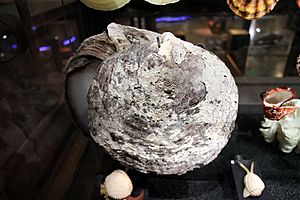Pinctada maxima facts for kids
Quick facts for kids Pinctada maxima |
|
|---|---|
 |
|
| Scientific classification | |
| Genus: |
Pinctada
|
| Species: |
maxima
|
The Pinctada maxima is a special type of pearl oyster. It lives in the ocean and is a kind of bivalve mollusk. This means it's a soft-bodied animal with a two-part shell.
These oysters are the biggest pearl oysters in the world! They have a very strong inside layer of their shell. This layer is called nacre, or "mother of pearl." It's the same shiny material that pearls are made of.
There are two main kinds of Pinctada maxima: the Silver-lipped oyster and the Gold-lipped oyster. They are super important for making beautiful South Sea pearls.
The South Sea pearl is so special that the Philippine President Fidel Ramos declared it the national gem in 1996. You can even see this oyster and its pearl on the back of the Philippine 1,000-peso bill!
About the Pinctada maxima Oyster
Pinctada maxima oysters can grow very large. They can be up to 12 in (30 cm) across! That's about the size of a dinner plate.
The two types, silver-lipped and gold-lipped, have different colors on the inside edge of their shells. This "mother of pearl" color affects the color of the pearls they create. Things like water temperature, tiny ocean plants (plankton), and sand can change which color oyster is found more often in different areas.
How South Sea Pearls Are Farmed
Pinctada maxima oysters create South Sea pearls. These pearls come in many beautiful colors. You can find them in white, silver, champagne, and gold.
Another type of oyster, Pinctada margaritifera, makes pearls often called Tahitian pearls or black pearls. These can be gray, platinum, charcoal, or even a deep purple color.
Today, South Sea pearls are mostly grown in Australia, Indonesia, Tahiti, and the Philippines. Because these oysters are so big, they can make very large pearls.
In Australia, pearl farming happens near Broome. The Australian South Sea Pearls are famous for their white or silver color with pink hints. They can grow to be very big, sometimes over 18mm. They are usually harvested after about two years.
In the Philippines, farmers mostly grow golden pearls from the gold-lipped oysters. These golden pearls are becoming very popular, especially in China!
Pearl Meat: A Special Food
The Pinctada maxima oyster also provides a special food called pearl meat. This is the strong muscle that the oyster uses to open and close its shell.
Australian pearl meat is known as a sustainable seafood. This means it's caught in a way that protects the ocean and its creatures. Only a small amount, about six tons, is gathered each year.
Pearl meat looks like a clear, round piece of scallop. It tastes sweet and has a firm texture. Some people say it tastes like a mix of calamari and lobster!
It's been a prized food in Asia for hundreds of years. Pearl meat is also very healthy. It's a great source of Omega 3, which is good for your brain and heart. It's also high in protein and has important vitamins like vitamin A and vitamin E. Plus, it contains calcium, iron, zinc, and iodine.

